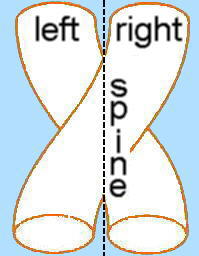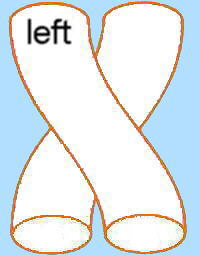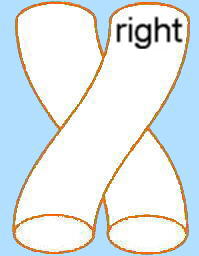 SUPPORTING ISRAEL WHERE JEWS ARE REBUILDING THEIR OFT-INVADED ANCESTRAL HOMELAND
SUPPORTING ISRAEL WHERE JEWS ARE REBUILDING THEIR OFT-INVADED ANCESTRAL HOMELAND 
| THE WELL-FORMED CHALLAH SITE NAVIGATOR click for... |
2-twist
3-braid
4-braid
5-braid
6-braid
bibliography flour packets glossary links |
|
URL: http://www.nationalfinder.com/wfc/index.htm
Facsimile, U.K.: +44 (0)20-8800 2903 E-mail: challot@nationalfinder.com |
Compiled by Roger Shlomo Harris
Updated: 19 November 2012 Copyright 2006-2012 |
and some other Jewish plaits and braids
 |
This miniature challah bread is only 4 inches (10cm) in length and is made of marzipan by Oppenheimer Ltd., Jerusalem. It is kosher and its packaging bears the hechshers of the Badatz Eida Chareidis, Israel and the Chief Rabbinate of Jerusalem. |
Take a piece of bread dough, roll and pat it into a disk, poke a hole through it and you have a zero, O, which is a symbol for nothing. Apply a 180 degree twist around a diameter and you have the symbol for infinity, ∞, i.e. everything. Somewhere in the mathland between nothing and everything lies a region inhabited by plaits, braids, knots ... and challah breads.
While the symbol for zero may be represented by a bagel, that quintessential Jewish soul food may also help to define the symbol for infinity. A plane surface which intersects a toroid (bagel) in a particular way creates an internal surface which is called "lemniscate" and which defines the familiar symbol, ∞.
Thus the humble bagel provides symbols for something without a beginning or an end, for nothing and everything. A great rabbi once said of the bagel, "turn it, turn it, for everything is in it."
Plaiting and knotting have many expressions within the ritual objects of the Jewish faith:
- tallis and tallis katan: tzitzit
- tefilin: the knots in the straps close to the phylacteries
- tefilin: the winding of the straps on the left or right forearm
- Shabbat: havadalah candles
- Sukkot: the holder (keshel, made of plaited palm leaves) into which the lulav (palm branch), aravot (willow) and hadassim (myrtle) are inserted
- Sukkot: the small loops of plaited palm leaf which hold the lulav fronds together
- Menorah and chanukiah: many instances of plaited arms and endless knots may be found in examples of 18th and 19th century CE Jewish papercuts. [more]
An interest in topology, i.e. the branch of mathematics which deals with the shaping and reshaping of malleable substances, led to finding that there were several unrelated objects which were topologically identical to various plaited breads.
- 2-twist: shofar, bagel, macaroni stick
- 3-braid: two-hole button, lemniscate, washing cup (netilat yadaim) with two loop handles
- 4-braid:
- 5-braid: four-hole button
- 6-braid:
- 9-braid: penny whistle
- 10-braid: violin
- 12-braid: seven button shirt with double cuffs
Giving something a name is the first step in learning about it so there is a glossary of terms. Plaiting and braiding both may refer to human hair and bread dough. Bread weaving is much less known than lattice work which is applied to pies and some other baked products.
Repetitive processes such as bread plaiting also need to be described but words and sentences can overwhelm one very quickly so I shall use a simple notation to describe the plaiting of a many-stranded loaf; the minimum number of parameters and operations from which the plaiting procedure may be calculated.
- a concise yet explicit description of the loaf's braiding which may be used to replicate the loaf
- Assume some kind of plaiting machine
- computer languages such asBASIC or C++
- a terse computer language such as APL
- the minimum number of parameters from which the precise plaiting procedure may be deduced.

At its simplest, plaiting involves the twisting of strands around each other according to a scheme and for a specified number of iterations. On this web-site the twists are notated by a two-part number string, sd, which encodes the spine (s) around which the twist revolves and the direction (d) of the twist; e.g. 10 (spine 1, clockwise), 31 (spine 3, anti-clockwise), etc.
|
|
Direction: clockwise, d = 0

Starting from the top, the left-hand strand crosses the right-hand strand. |
Direction: anti-clockwise, d = 1

Starting from the top, the right-hand strand crosses the left-hand strand. |
The Purim challa, called keylitch in Russian, is giant-sized and braided to represent the ropes used to hang Haman.
SOURCE: The Jewish Book of Why [page 276], by Alfred J. Kolatch, 1981, 1995. ISBN: 0-8246-0256-0
Here is a round challah:
